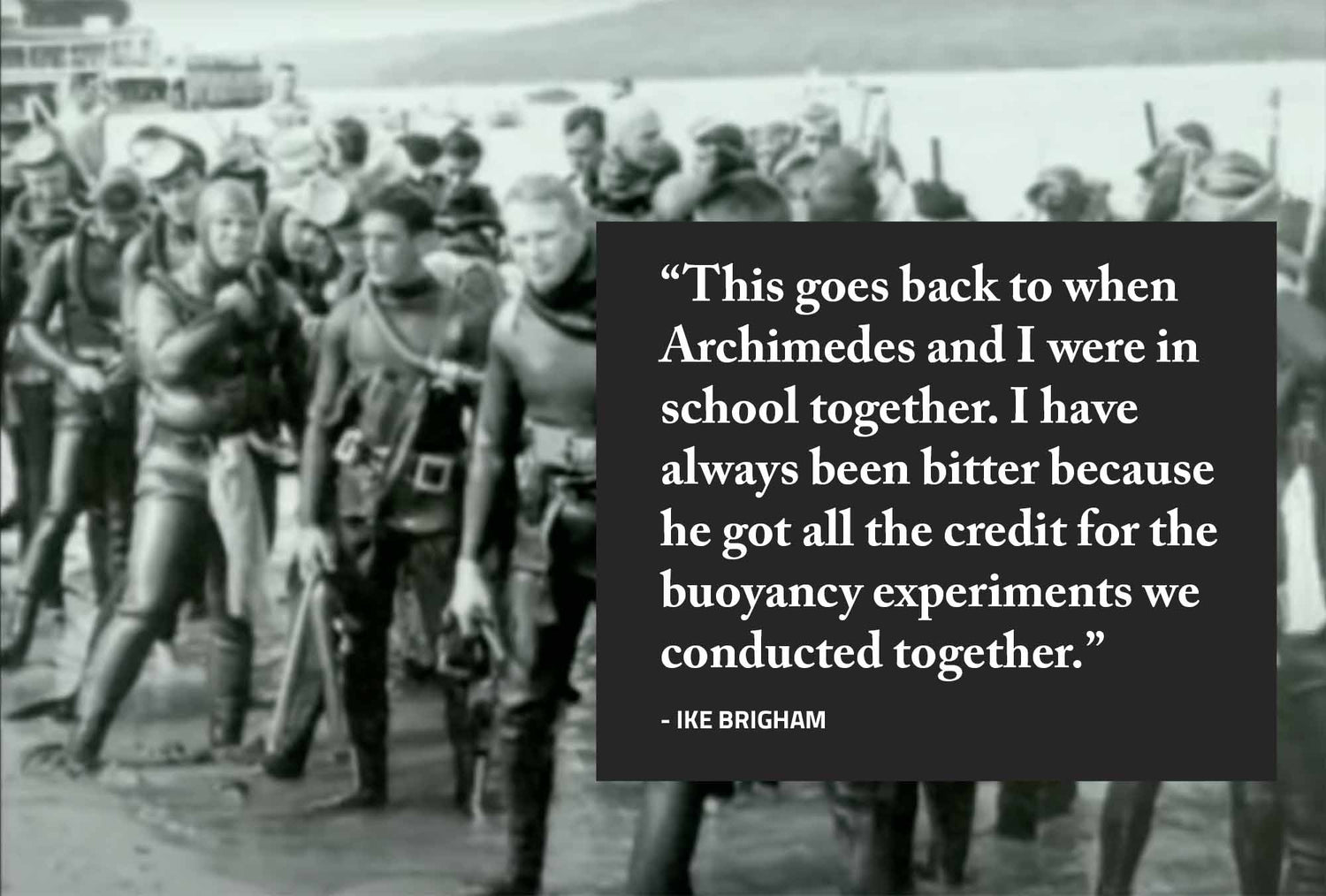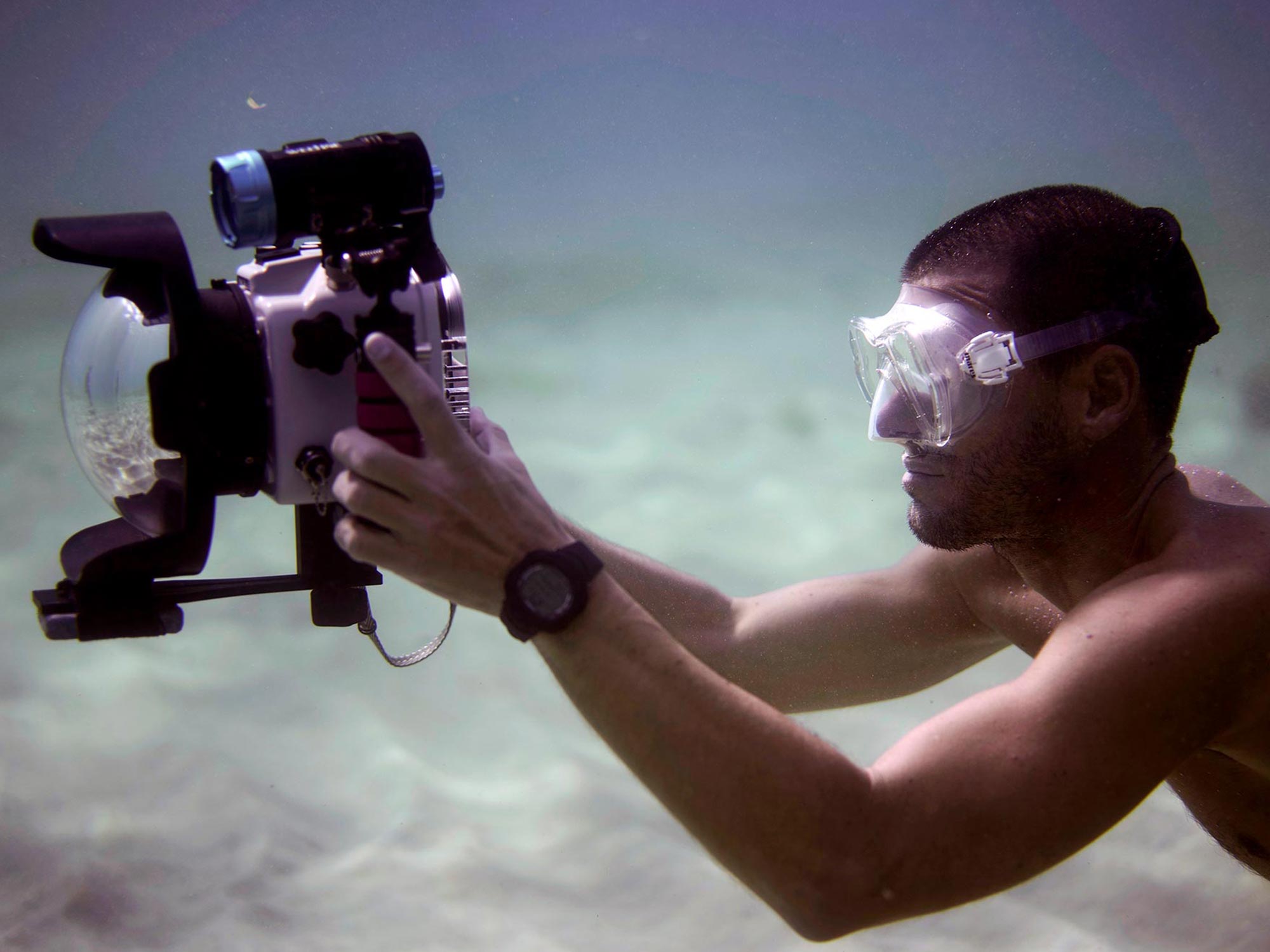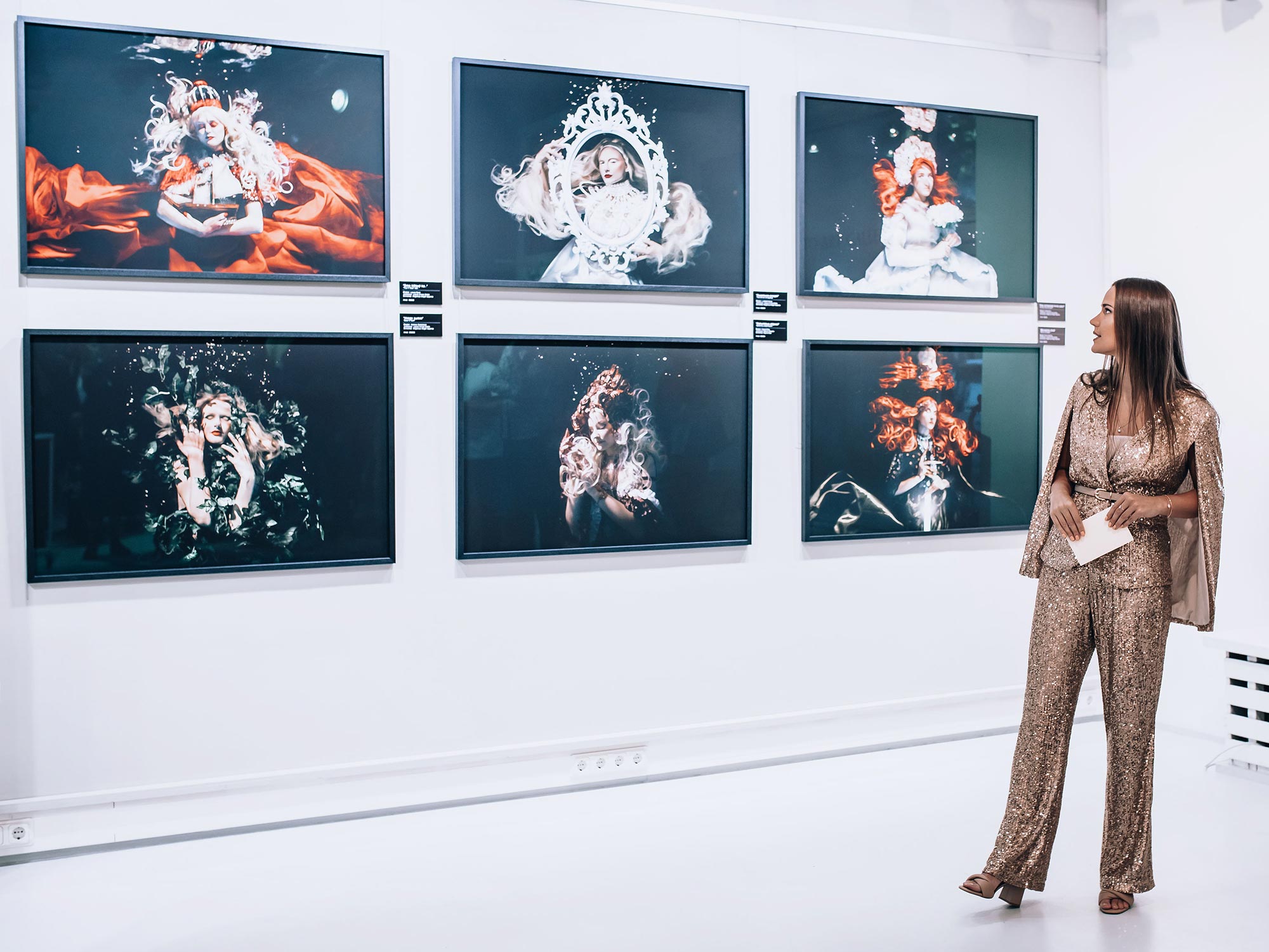By Jean Rydberg
Growing up with Ike Brigham as a father didn't teach me anything about underwater photography (or even what a housing was). But it did teach me that anything was possible if you were willing to work for it.
1937
Born in Louisville, KY, and raised in Indianapolis, IN, the young Ike Brigham was an entrepreneur from the start. He was raised like an only child with a much older brother and sister having already moved out of the house. He was said to have marched around "like a little General Ike Eisenhower" by his brother who served in the U.S. Navy in Would War II. The nickname stuck. In his early teens he operated a thriving bicycle repair business, "Ike's Bikes," complete with printed business cards.
Late 1950's
In spite of his father serving as the distinguished head of the Indiana State Library for many years, Ike wasn't much for book learning. After high school he spent one semester in the Purdue University School of Engineering before becoming bored and returning home to his high school sweetheart. He joined a family friend and mentor in running a business specializing in surface finish repair and painting appliances in the style of the day. In the late 1950's they purchased a load of inventory from a man who was running a dive shop out of his garage. They started offering wares in their previously empty storefront under the name Diver's Supply Company.

Ike is most likely the fully clothed fellow gearing up in the foreground while his first wife and two young children observe from the shore of the dive site. Ike spent all of his free time in the 1960's diving with a close-knit crew of midwestern divers.
Ike was an avid diver traveling up to the Great Lakes on the weekends where running salvaging missions on old shipwrecks was en vogue. Most notably, Ike was one of the team that brought back several artifacts from the wreck of the William H. Barnum which sunk off the coast of Mackinac Point in 1894. Dive lights were essential in the dark, deep waters.
At the time underwater flashlights were notoriously unreliable. Ike returned to Indianapolis at the end of one weekend hauling four imploded lights in his trunk. While ruminating on the disaster, he started thinking about a better way to design a dive light. His first prototype was hand poured and cured in an old Westinghouse oven in the back of the shop. He debuted his novel new design at the NSGA show in Chicago and caught the attention of Dacor, who began selling the light with their company name emblazoned on the handle.

(left-to-right) Jerry Boyd, Fred Leete, and Ike Brigham pose proudly with artifacts salvaged from the William H. Barnum which sunk in the Great Lakes in 1894.
1962
Ike started to become known through the dive show circuit and more and more dive store owners started to phone in requests for "Ike's Lights." The name IKELITE® was trademarked in 1962 and Ike moved on to solving his next greatest problem: how to have a dry cigarette and lighter on hand when he surfaced after his dive. His second major product, the clear cylindrical waterproof Accessory Case, was not quite as big of a hit but did find a number of interesting uses over the next 40 years.
In 1964, Ikelite was the first manufacturer to introduce a dive compass with a rotating bezel for course comparison.
The Undersea World of Jacques Cousteau started airing in 1966 and recreational scuba diving was experiencing a huge boom. Like the underwater Gold Rush, there were opportunities to improve the experience of the scuba diver at nearly every turn. Ike was the first to add a rotating bezel to the underwater compass, which would feel naked and a little useless now without one. Now familiar with the molding process, Ike set his sights on what was to become the true cornerstone of the IKELITE product line: photography.

In the early days we were half a block north on the corner of 34th and Illinois. The 1966 catalog featured a wide variety of goods from the expected to the unexpected, like ash trays featuring scuba-related cartoons and a "diver down" flag for the top of your car antenna. Ikelite's "fascinating accessories" include the accessory case (prominently featured in the middle of the cover page), the dive compass with a rotating bezel, and the deluxe model IKELITE lantern flashlight with sealed beam bulb, redesigned toggle switch boot, and choice of black or clear case at a cost of $16.95. The light was advertised as leakproof, pressure proof, and foolproof.
Late 1960's
In the mid-sixties Ikelite moved down the street to our current home and Ike introduced seamless underwater camera and flash housings. The Nikonos waterproof camera was already popular among divers in the day. Waterproof housings, on the other hand, allowed divers to take a wide variety of affordable cameras with them on their dive. Most housings at the time were glued or joined together with seams that reduced reliability. Ike invested considerably in tooling to produce injection molded cases using GE Lexan® polycarbonate to produce a clear, highly durable enclosure.
Housing kits with two controls sold for as little as $29.95 and offered the advantage of being able to see a slight leak in time to save their camera. For divers using more than one roll of film, a well designed housing allowed the photographer to change film in a dry camera. Ike pioneered quad-ring controls seals and was the first to use lid snap closures on an underwater housing.
[1969] "Underwater photography proves to be one of the most rewarding endeavors of a diver. Through pictures he conveys the underwater splendor for all to enjoy. And he enhances the diver image as a sportsman and professional." - Ikelite Catalog
[2001] "The industry must recognize that underwater photography remains the easiest vehicle to promote diving. An underwater photo should be taken of each student in every class and given to them so they can show it to their friends." - Ike Brigham Reaching Out Award Speech
1970's
Ike stopped diving in the early 70's after divorcing his first wife and dive buddy for the previous two decades. He kept his focus on running the business and connecting with the needs of the expanding customer base. The Company grew with the enthusiasm of the dedicated scuba divers on the team, including David Combs (General Manager), Thomas Kepler (Vice President), Gale Livers (Design & Marketing), Sylvia Livers (International Sales), Larry Ostendorf (Lead Engineer), Bob Mayes (Dive Store Manager), Bob Stubbs ("Stubby" / Dive Instructor), and more.

Ikelite went on to blaze the trails of underwater photography by overturning the underwater flash market. Photographers at the time were limited by strobes dedicated to the camera system they were shooting with. These strobes weren't interchangeable between camera manufacturers. Ikelite was the first to separate the electrical cord from the strobe unit and make it detachable with a waterproof connection for interchangeability. This represented a revolution for divers stranded with a broken unit looking to borrow a strobe while diving in a remote location. From there the records of Ikelite firsts grew into a long list of now-standard features: aiming lights, audible ready signals, removable battery packs, battery power indicators, smart charging, wireless TTL slave sensors, and more.
1980's
The 70's and 80's were an explosion in underwater photography with rapid development of all types of systems from Kodak Instamatics and Polaroids (yes, we housed those too) to film SLRs and motion picture cameras. In addition there were continuous advancements in flashlights, compasses, strobes, video lights, and random accessories including attention grabbing product like the Clicker, the Screamer, and the Sea Popper. In July 1984, Ikelite started shipping the DIGITAL DIVE LOG DDL-1000, a waterproof watch and dive timer. The predecessor to modern day dive computers, the DDL-1000 was automatically water activated and capable of recording your last 7 bottom times and surface intervals.
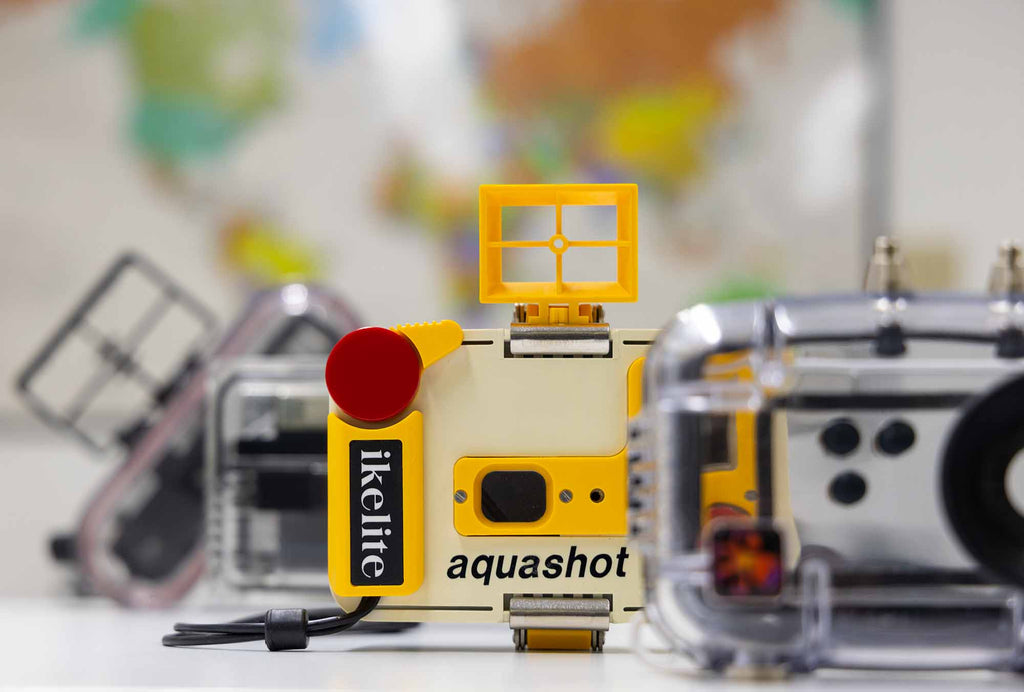
1990's
July 1990 marked the end of an era for Ike and Ikelite: the closing of the Diver's Supply store front on North Illinois Street. The space old dive shop quickly filled up with storage of Ikelite parts as production expanded quickly with the announcement of the Aquashot system. This compact housing reminiscent of Ronald McDonald exploded onto the scene and we could hardly build them fast enough. The Aquashot I accepted disposable/recyclable 35mm film cameras from Fujifilm and Kodak. It promised 24 frames of success "in the hands of a diver unfamiliar with photography [by offering] one suggestion - shoot underwater subjects between 2 and 6 feet away."
Ike recognized the importance of computer technology in running a business, spending many of his evenings customizing the software for the Company's robust ERP system. He also saw early on that email and the web would become the most important ways to introduce new products and connect with the public. Ikelite was one of the first companies in the dive industry - and the world - to launch a consumer focused website. The web catalog ikelite.com premiered on July 1, 1996, one month before nike.com went live.

Our website ikelite.com first launched on July 1, 1996 and was optimized for the Netscape 2.0 web browser. The website was designed by long-time Head of Marketing, Gale Livers, and ultimately kept up-to-date by Ike. In Ike's mind the website quickly made printing catalogs obsolete, shifting from a new print catalog every year to one every 3-4 years and eventually not at all. At the rate we release new products, a print catalog's information is incomplete before the ink has dried.
2000's
The 21st century started with a big high and a big low for Ikelite. The Dive Equipment & Marketing Association (DEMA) recognized Ike's achievements with their Reaching Out Award, created to recognize individuals who have made a significant contribution to the sport of diving by "reaching out" in some special way to improve the sport for everyone.
That same year, the Ikelite office was totally destroyed by fire. The insurance company attempted to blame the fire on Ike's notoriously messy office and 3 pack a day smoking habit. Luckily, there was photographic proof that his office had received a thorough cleaning which included removal of every stack of paper and all the layers of dust and ash. In a second act of fortune, Ike was militant about backing up the computer data every single night to a Zip disk that he carried home in his brief case (this is way before cloud storage was common). Within 24 days, we were able to get the offices up and running - back in the old dive shop area - without any loss of product or sales data.

The rise and fall of disposable cameras was a perfect segue into the next era of photography: digital. The digital boom came with both volume and variety. In 1998 we debuted the digital case with two model options: Sony Mavia MVC-FD7 and Hitachi MP-EG1A cameras. By 2000 there were 11 models. By 2010, we had 90 current models - not including camcorders.
Ike at Home
Ike's two enduring passions in life were his work computer and his car collection. The first thing he did when he returned home from work was to turn his computer on to check emails and the day's business metrics. Those who corresponded with him through the years recognized his witty one-liners that often arrived in their inbox long after midnight. Ike was a regular on the burgeoning online photography forums and newsgroups (when those were a thing), helping users and non-users through their equipment issues.
In his free time, Ike enjoyed tinkering with his antique car collection and driving a different car to work every day. His collection included six Packards ranging from 1927 to 1955, a team of "summer" and "winter" (i.e. convertible and coupe) Corvettes, and his very first car. The latter is a 1927 Packard that he paid $175 for as a 16-year-old kid. He hitched a ride up to northern Indiana to pull it out of an old man's barn. It was a convertible with a broken rag-top so he bore the worst of Indiana winter weather as he drove it home back home to Indianapolis in a raging snowstorm. He upgraded at his first opportunity but kept track of the car through the years and bought it back in the early 1990's.
Ike and his wife, Sandra, were active in a number of national car clubs including the Classic Car Club of America (CCCA). They enjoyed hosting parties and coordinating events for the clubs and for many years Ike served as Editor of the Hoosier Horn, the quarterly newsletter for the Indiana Region CCCA.
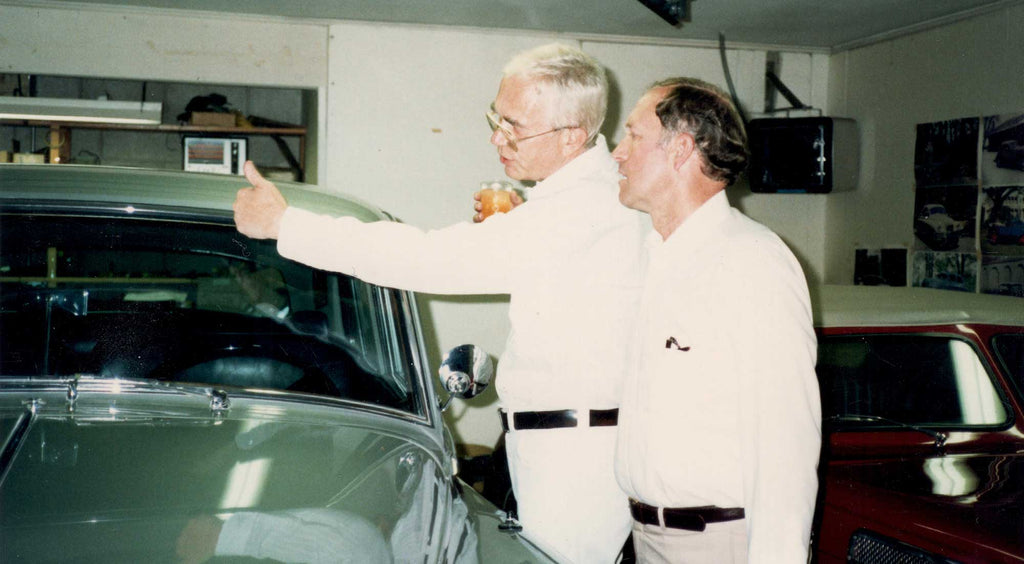
Ike discusses his cars with long-time friend and fellow collector Gene Perkins. Most of his cars were American made with the exception of this 1965 Rolls Royce Silver Cloud III, and his prized 1955 XK-140-MC convertible and 1953 XK-120 coupe Jaguars. He also tucked in a 1976 Triumph TR-6 that he had retrofitted with the 350 horsepower engine from a 1978 Corvette he also owned.
It's hard to picture my father without a pack of Marlboro Reds in his shirt pocket. Decades of smoking three packs a day eventually caught up to him. Ike passed away in 2006 and passed the company he built down to the next generation of Brighams who grew up playing in the factory, building flashlights during summer breaks, and wondering why he never moved his mini-empire out of the Midwest.
"I must admit to being nervous because there are those that think a roast or a lynching might be more appropriate. I am flattered and a little embarrassed by all of this, especially considering the accomplishments of industry super stars like Bob Hollis [Oceanic], Allen Uke [Underwater Kinetics], and Dave Parker [Pelican Products]."
- Ike Brigham, when receiving the 2001 DEMA Reaching Out Award for his lifelong contributions to the dive industry
Today, Ikelite is run by two of Ike's five children, with myself as President & CEO John Brigham as Vice President. Ike was proud of all of his children and didn't force any of them to follow in his footsteps- in fact, he often warned against it (aside from a practical suggestion to "take a few business classes" in college, which was scoffed at). Ike worked on the business every day of his life- even when he could barely breathe from COPD and emphysema. He knew the tremendous highs and the crushing lows that the retail market can bring.
It's hard to believe that we've been at it for over 60 years as a company - and already over 1/4 of them without Ike at the helm. John and I are both divers and photographers. We're lucky to lead a team that includes both 30+ year veterans and excited newbies. And we remain committed to bringing the wonders of the underwater world to surface through affordable technology.
 Jean Rydberg, daughter of Ike Brigham, became President & CEO of Ikelite in 2006. Prior to that, she wisely pursued a degree in Astronomy & Astrophysics to prepare herself for the challenges of running a technology-driven manufacturing business with global distribution. Jean fully embraces the need to travel outside of her hometown of Indianapolis to experience good diving. She believes that any camera is capable of amazing results in the right hands, and anyone can become a great photographer given the right advice. When she's not working she's spending time with her husband, cats, and two daughters (though not necessarily in that order).
Jean Rydberg, daughter of Ike Brigham, became President & CEO of Ikelite in 2006. Prior to that, she wisely pursued a degree in Astronomy & Astrophysics to prepare herself for the challenges of running a technology-driven manufacturing business with global distribution. Jean fully embraces the need to travel outside of her hometown of Indianapolis to experience good diving. She believes that any camera is capable of amazing results in the right hands, and anyone can become a great photographer given the right advice. When she's not working she's spending time with her husband, cats, and two daughters (though not necessarily in that order).
Additional Reading
The Next Generation of Professional Underwater Strobes
Diving Bikini Atoll and the Legacy of US Nuclear Testing [VIDEO]
Where Postage Stamps, Cancer Research, and the Smithsonian Museum Meet
My Journey from Underwater Stills to Video
Our Favorite Underwater Photography Podcasts
Building the Next Generation Backyard Underwater Photo Studio











